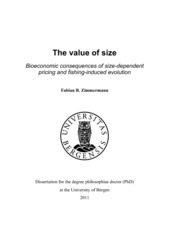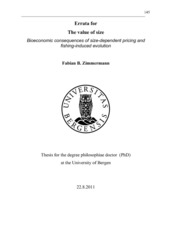| dc.contributor.author | Zimmermann, Fabian | eng |
| dc.date.accessioned | 2011-11-14T08:20:48Z | |
| dc.date.available | 2011-11-14T08:20:48Z | |
| dc.date.issued | 2011-09-02 | eng |
| dc.identifier.isbn | 978-82-308-1816-9 (print version) | en_US |
| dc.identifier.uri | https://hdl.handle.net/1956/5177 | |
| dc.description.abstract | The influence of fishing on the dynamics of fish stocks is a core element in fisheries management. One of the most notable characteristics in this context is the sizestructure of a fish stock, composed by the individual and its body size. From a biological perspective, individual size is directly linked to most relevant life-history traits like growth, maturation or reproductive output, connecting it to evolutionary processes. In the context of fisheries, individual fish constitute the harvested biomass and therefore its overall value. In addition, individual size possesses an intrinsic economic value: Commonly, bigger fish are more valuable than smaller ones and fetch higher prices per weight unit. Thus, size-dependent pricing underlines in economic terms the relevance of individual size, and suggests at the same time an interaction with demographic shifts through fishing. Generally, policies accounting for individual growth and size structure can improve yield and economic returns, therefore an interactive influence of sizedependent pricing on optimal harvest strategies is likely. Similarly, to take into account the impact of potential evolutionary changes in stock composition through fishing could improve the long-term economic benefits from fisheries. In paper I and II, the influence of size-dependent pricing on optimal harvest strategies is evaluated. Positive relationships between individual sizes of fish and the prices per weight unit fishermen receive are widespread in commercial fisheries. This underlying hypothesis is evaluated in Paper III with a statistical analysis of price data from Norwegian fisheries. Furthermore it is commonly assumed that such size-dependent pricing can influence the optimal catch composition maximizing economic rent. This raises the question whether the impact on optimal harvest strategies and corresponding maximum economic yield is of significant magnitude, and hence should be considered in management decisions. Paper I addresses this issue with age-structured models parameterized for two pelagic fisheries in Norway, targeting Atlantic herring (Clupea harengus) and Atlantic mackerel (Scomber scombrus). Here positive size-dependent pricing results in lower optimal harvest, higher average catch size and influences net present value. On the other hand, paper II provides an analytical approach, introducing size effects into a generic Gordon-Schaefer type model. The assumption of a negative relationship between fishing effort and average individual size emulates a fishinginduced truncation of size structure, while mean catch size is positively related to price to account for size-dependent pricing. This allows for tracing how such size-dependent effects change the patterns of optimal harvest paths and sustainable revenue in fish stocks. The results show a decrease of optimal effort and harvest with increasing strength of size effects. Therefore, Paper I and II suggest that ignoring the impact of fishing on size structure of fish stocks as well as size-dependent pricing could result in suboptimal management strategies and rent dissipation. Paper III underlines this conclusion and demonstrates that size-dependent pricing is indeed relevant in Norwegian fisheries. In Paper IV, a simplified evolutionary life-history model was utilized to explore potential economic consequences of fishing-induced evolutionary changes. The underlying assumption is based on evidences that harvesting of fish stocks changes survival probabilities and therefore selection landscape for life-history strategies, resulting in adaptations of corresponding traits like maturation age. Hence, the model focuses on age at maturation as basis of stock dynamics for a cod-like species, while fishing is described by fishing mortality and size selectivity. Combined, these parameters determine the resulting yield and net revenue of the simulated fishery. A comparison of this model with a non-evolutionary version allows for an impact analysis of harvest strategies on life history evolution and the long-run economic consequences. The results predict an influence of fishing-induced evolution on stock biomass and composition as well as yield and economic rent. However, the quantitative impact is marginal even under low discount rates and the consequences for optimal harvest patterns moderate. Negative economic consequences are present for stocks managed within the range of maximum economic yield, while evolutionary adaptation provides beneficial resilience towards high fishing pressure. Nevertheless, under consideration of fishing-induced evolution fishing mortalities maximizing economic rent remain nearly the same for most parameter values, implying that optimal harvest strategies are not significantly affected by an evolutionary component. Additionally, the results show high sensitivity to discounting: Increasing discount rates render the influence of fishing-induced evolution irrelevant even on the level of low to moderate discount rates. This highlights the problematic effect of discount rates in long-term cost-benefit calculations, and calls for a careful use of discounting in view of small but detrimental changes over long time periods. | en_US |
| dc.language.iso | eng | eng |
| dc.publisher | The University of Bergen | en_US |
| dc.relation.haspart | Paper I: Zimmermann F., Heino M., and Steinshamn S. (2011) Does size matter? A bioeconomic perspective on optimal harvesting when price is size-dependent. Canadian Journal of Fisheries and Aquatic Sciences 68(9): 1651-1659, September 2011. The article is available at: <a href="http://hdl.handle.net/1956/5171" target="blank">http://hdl.handle.net/1956/5171</a> | en_US |
| dc.relation.haspart | Paper II: Zimmermann F., Steinshamn S., and Heino M. (2011) Optimal harvest feedback rule accounting for the fishing-up effect and sizedependent pricing. Natural Resource Modeling 24(3): 365–382, August 2011. Full text not available in BORA due to publisher restrictions. The article is available at: <a href="http://dx.doi.org/10.1111/j.1939-7445.2011.00095.x" target="blank"> http://dx.doi.org/10.1111/j.1939-7445.2011.00095.x</a> | en_US |
| dc.relation.haspart | Paper III: Zimmermann F., and Heino M. Size-dependent pricing in Norwegian fisheries. Full text not available in BORA. | en_US |
| dc.relation.haspart | Paper IV: Zimmermann F., and Jørgensen C. The bioeconomic consequences of fishing-induced evolution: A model predicts limited impact on net present value. Full text not available in BORA. | en_US |
| dc.title | The value of size. Bioeconomic consequences of size-dependent pricing and fishing-induced evolution | en_US |
| dc.type | Doctoral thesis | |
| dc.rights.holder | Copyright the author. All rights reserved | en_US |
| dc.subject.nsi | VDP::Agriculture and fishery disciplines: 900 | en_US |

